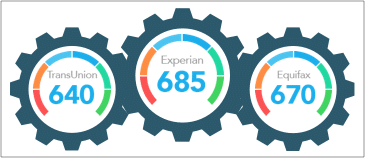When you apply for credit, the lender will pull your credit score from one or more of the three credit bureaus: Equifax®, Experian® or TransUnion®. But that’s not the only variable. There are various credit scoring models, and your scores could be slightly different depending on which credit scoring model your lender chooses to pull.
The most used credit score models are the FICO® score and VantageScore®. While FICO and VantageScore have many similarities, they have some key differences. And because consumers can’t pick which credit scores a lender will view, or from which of the three credit reporting agencies a creditor will pull their report and score, it’s smart to understand both types of scores and how they might alter your credit profile.
The History of FICO and VantageScore
FICO, an acronym for Fair Isaac Corporation, was founded in 1956 by engineer William Fair and mathematician Earl Isaac. The company developed its credit scoring system to sell to lenders to help them determine a potential borrower’s creditworthiness. For its first two decades, FICO worked with individual lenders to develop customized credit scoring models that would work specifically for their customers and their business models.
In 1989, FICO worked with the national credit bureaus to develop a credit scoring model that could be used by all lenders and companies to evaluate any consumer. By the mid-1990s, credit scores had become a standard part of the lending decision process.
In 2006, the three credit bureaus, Equifax, Experian and TransUnion, developed VantageScore as an alternative to FICO scores. VantageScore, an independently managed company, has since been accepted by lenders and consumers in most credit categories.
How Are FICO and VantageScore Similar?
The two most common credit scoring models have several similarities, including:
Score Ranges
Both FICO and VantageScore use a scale of 300 to 850. But there are subtle differences within the ranges. Because VantageScore offers more categories within its score range, consumers can easily get a more specific idea of where they stand.
VantageScore Scale
- 810 – 850 = Excellent
- 750 – 809 = Great
- 670 – 749 = Good
- 560 – 669 = Fair
- 500 – 559 = Poor
- 300 – 499 = Very Poor
FICO Scale
- 800 – 850 = Excellent
- 740 – 799 = Very good
- 670 – 739 = Good
- 580 – 669 = Fair
- 300 – 579 = Poor
Credit File Sourcing
Both FICO and VantageScore gather consumer credit files from the three credit bureaus: Equifax, Experian and TransUnion.
Rating Criteria
The factors that matter most to your scores are similar for both FICO and VantageScore. For example, both scoring models prioritize payment history, account mix and credit age, and credit utilization most heavily in determining your score.
Paid Collection Accounts
With both FICO and VantageScore, collection accounts you have paid off no longer count against you.
Multiple Credit Inquiries
Both FICO and VantageScore penalize you for multiple hard inquiries within a short time frame.
How Are FICO and VantageScore Different?
Despite their similarities, FICO and VantageScore have some important distinctions.
Scoring Requirements
In order to create a credit score for an individual, FICO requires at least six months of credit history and at least one credit account reported within the last six months. On the other hand, VantageScore only requires one month of credit history and one account reported within the past two years.
This difference means that between 30 million and 35 million people who are considered “unscorable” by FICO can be issued credit scores through the VantageScore model. That’s why VantageScore is known as a more consumer-friendly credit scoring model.
Rate Shopping
When seeking financing for a home, auto or student loan, both credit scoring companies count multiple credit inquiries as a single inquiry under certain conditions. The difference between VantageScore and FICO is the time frame allotted to shop for rates. FICO’s shopping window is larger, allowing 45 days to compare rates. VantageScore allows just 14 days for rate-shopping.
Late Payments
If you have a history of late payments, both VantageScore and FICO scores take a hit – but depending on the type of account, the impact will differ.
- FICO treats all late payments the same, whether it’s your credit card or mortgage.
- VantageScore judges late payments differently – with mortgages carrying a heavier penalty than a credit card or other type of credit.
- For consumers whose creditors note that they have been affected by a natural or declared disaster, VantageScore counts negative information as “neutral” during that time but continues to reflect positive information in their score calculations.
Understanding the different types of credit scores is important, but understanding what’s in your individual credit reports and scores is the only way you can make informed financial decisions and plans. ScoreSense® makes it easy to stay updated on your credit information by tracking all three of your credit reports and scores. If you’re not a member, try a 7-day trial now.




